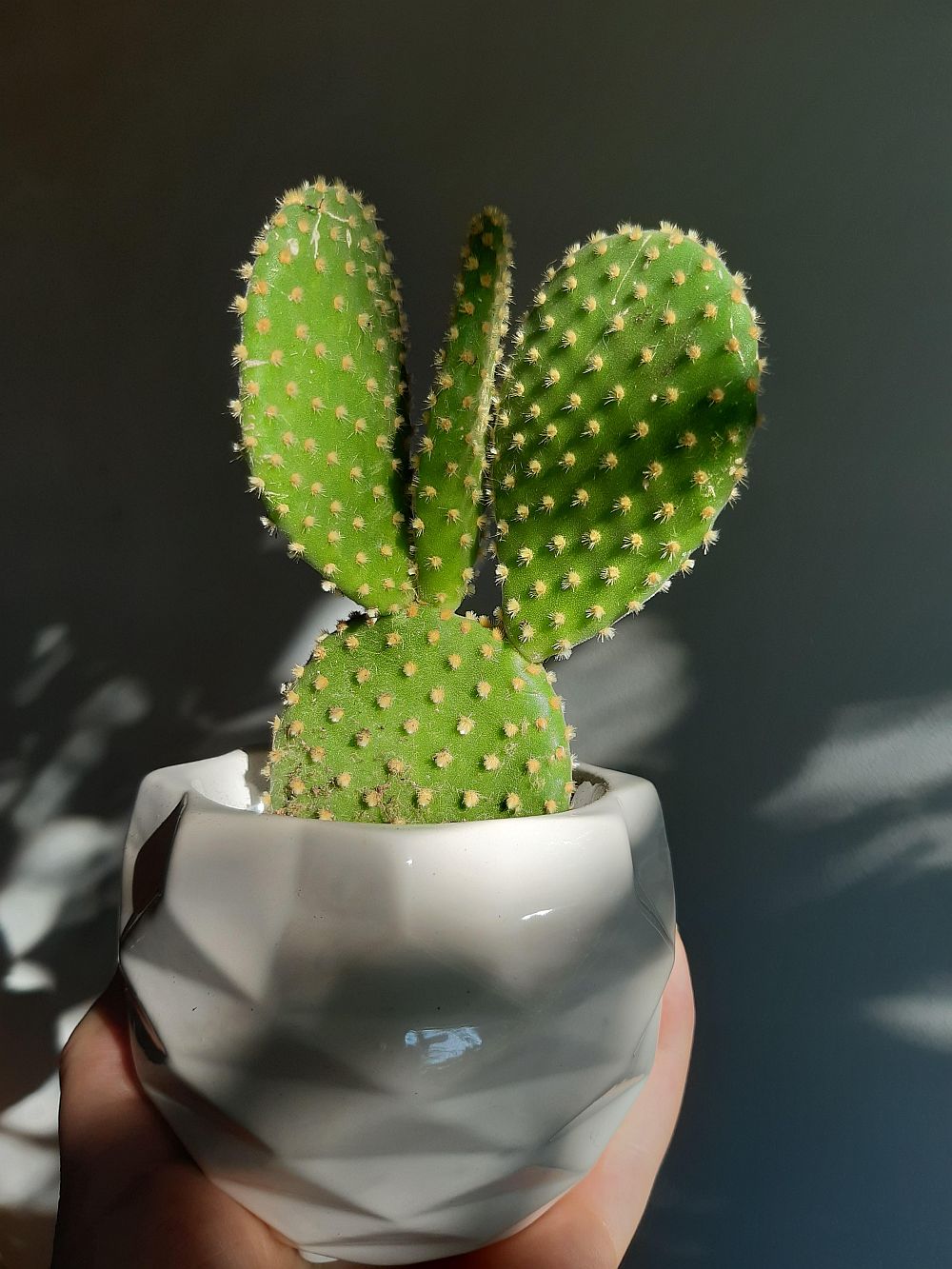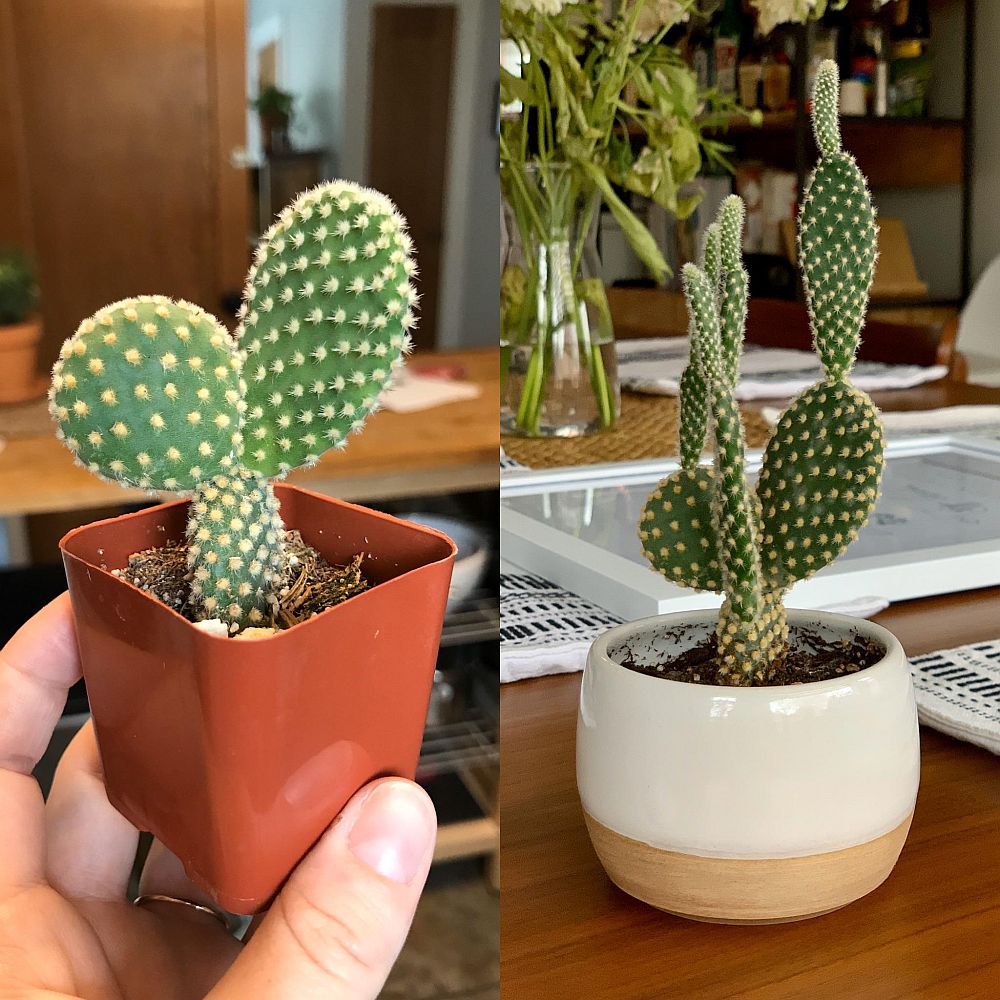Bunny Ear Cactus: Growing & Care For the Bunny Ears Succulent (Opuntia Microdasys)
Cactus plants or succulents are making their presence known in gardens, terraces, and lawns everywhere you look these days. Thanks to the wide variety of shapes, sizes, and blooms, cacti are capturing our hearts and tickling our skin with their famous spines.

So what happens when you add in extra cuteness to the mix of this litany of colors and landscaping delights? You get the bunny ear cactus of course.
Named after the shapely pads which remind you of the ears of a rabbit or a prickly Mickey Mouse, it’s one of the easiest plants to grow. So let’s get a closer look at this cute cactus and see how you can grow it and care for it without scratching your hands.
Something that both beginners and seasoned horticulturalists seem to get a lot when handling the bunny ears cactus.
All About the Bunny Ears Cactus
A word of warning before we get to the nitty gritty details of what makes this specific succulent stand out of all the 1750 species of the Cactaceae family. Despite its cuddly look, it’s not a pet plant you can fondle or go all touchy-feely over. The bunny ears cactus is a plant to be admired from a distance.
Where do these ear cactus grow?
A native of the desert regions of Mexico, the shrub-like bunny ears cactus likes to spread around and grow to up to 5 feet when fully mature. It has other names such as the Polka Dot Cactus, but its scientific name is Opuntia microdasys. With no stem or leaves, the oval pads of the cactus give it a distinct look.
What are spines for?
The spines of the rabbit ear cactus are a defensive mechanism the same way the quills of the porcupine defend it against its enemy. They come off easily with the slightest touch and stick to the skin. Don’t try to pull them out since they’ll break in your skin. Instead, use a pair of tweezers to gently ease them out of your flesh then wash the area with water and soap.
How does the cactus bloom?
In the late spring, buds appear at the top of fully grown pads. By early summer, the buds open up into ravishing blooms about 2 inches each.
The flowers are creamy yellow mostly and some have pinkish hues. After they fertilize, the flowers fade, and a small fruit grows out of them. The fruit is about 2 inches long, covered in spines, and is often red or purple.
How to Grow the Bunny Ears Cactus
The good news is, this is a hassle-free plant that is used to the rough and tumble of the desert. It is easily satisfied with any nutrition at all and the occasional watering. This means that your average soil that other plants relish, will not do for our polka dot cactus.
To pot your bunny ears cactus, you can either mix your own clay or buy a pre-mixed cactus soil. To mix your soil yourself, use a portion of houseplant soil mixed with sand, pebbles, gravel, and peat moss.
The sand and gritty material is to help with aeration and drainage. The cactus doesn’t like being waterlogged and flourishes in dry soil. For best results, try to add bark and perlite to the soil.
Pick a clay pot for best drainage and ventilation and make sure it’s the unglazed type. Polka dot cactuses need to be repotted every couple of years to accommodate their growing root system. The best time for repotting is in the late summer after the bloom and fruit cycle and before the plant goes into dormancy.

The plant needs plenty of irrigation during its first year until the roots have established. This applies to repotting as well.
Cactuses are slow to grow roots, so water it steadily to encourage the roots to develop. Make sure the soil doesn’t get soggy. It’s okay for the topsoil to be dry as long as the rest of the pot is wet.
As for propagation, it’s easy with the polka dot cactus. In the late summer, after the fruits have ripened, that’s when you can clone your plant. Simply cut off a segment off the adult cactus and keep it aside for a few days. When the end goes dry and develops callus-like scales, you can plant it in a pot with the right mix of soil. Water it immediately and then once a week for the next year.
Bunny Ear Cactus Care
Now that you have a few pots of bunny ear cacti growing happily in your garden, it’s time to look at how you can care for them and make sure they get all the light, water, and nutrition they need.
Even though these are desert plants, it doesn’t mean they should grow to look scraggy and scruffy like their wild relatives.
Humidity and Light
As is the case with desert plants, our polka dot cactus enjoys an unobstructed exposure to air and sunlight all day long. If you’re growing the plant outdoors, then pick a spot that gets plenty of sun, preferably one facing south.
If it’s a potted plant and you have it indoors, then make sure it’s strategically placed in a window flooded with sunlight at least 4 hours a day. Absent the sun, keep a fluorescent light on in the room for 16 hours every day.
The hardy cactus tolerates high air temperatures. Any temperature above 100 degrees Fahrenheit suits its growing needs just fine. However, the flowers need a more moderate temperature between 45 to 55 degrees F. So during the bloom season (late spring and early summer), make sure to shield it from the glaring sun.
As for humidity, you should keep it to a minimum. Remember, we’re trying to replicate the conditions of the cactus original habitat in the desert. So, anything 10 to 30 percent humidity will do fine. If you can’t control the humidity, as is the case when growing it outdoors, then cut down on irrigation.
Water
The official classification of the bunny ears cactus by the USDA puts it anywhere between zones 9 and 11. As such, it’s not the kind of plant that needs lots of water.
The shallow roots of the cactus are designed to absorb the smallest droplets of water that hit the soil. Be it rain or morning dew. So you don’t have to water the plant regularly since the roots don’t do well in waterlogged soil and could rot easily.
The cactus can handle dry soil very well. So wait for the top inch of the soil to go dry, before you give it water. In the summer months, this might happen faster than in the cold months of the winter. It also depends on the levels of humidity in your area as we explained earlier.
Fertilizers
Just because the bunny cactus is used to the hostile conditions in the desert, doesn’t mean it will survive on the few nutrients in the soil in the pot until you repot it.
To get an abundance of flowers and fruits, you can give it a liquid fertilizer in moderate doses in the late winter and early spring. You can use a well balanced fertilizer or a 5-10-10 one for best results.
Use the fertilizer with every other irrigation. Once the fruits are ripe, hold back the fertilizer until the next season. During dormancy, fertilizers might burn the roots or cause unusual growth that affects the flowering cycle
Pests
As we have seen, it’s easy to grow and care for our hardy polka dot cactus. The same applies to pest control. Since the plant doesn’t have stems or juicy leaves, it doesn’t attract your usual run of the mill bugs and infections. However, the spines do attract spiders that use them to build cobwebs.
Other more dangerous insects attack the segments of the cactus to feed off the nutritious sap. Most notably are white mealybugs and other scaly insects. They usually pierce the thick skin of the cactus pads with their sharp teeth and attach themselves to the segments.
To get rid of these pests, you need to be as careful as you can. Be wary of the spines or glochids as you approach this delicate task.
It’s better to use a cotton swab soaked in rubbing alcohol held tightly with a pair of tweezers or tongs. Place the swap firmly on the insect to smother it with the alcohol. Usually, the insects let go of the plant and fall in the pot. Collect them and get rid of them in a bucket of water with a mixture of detergent.